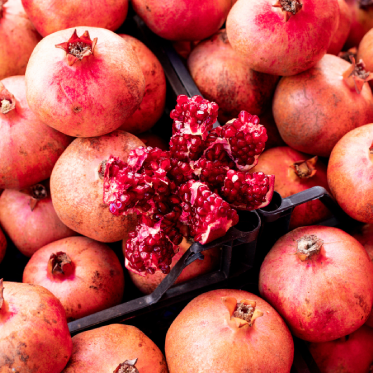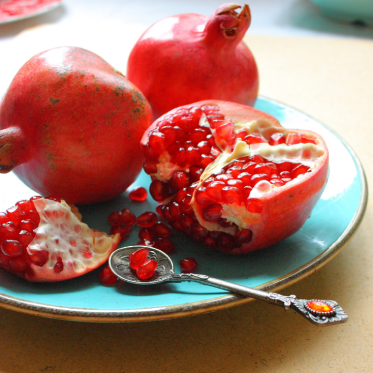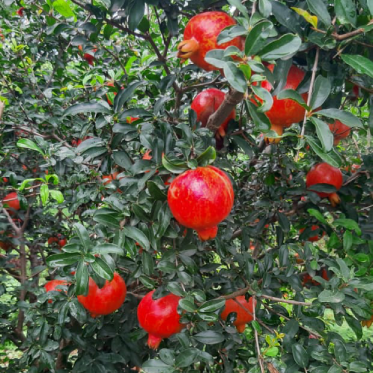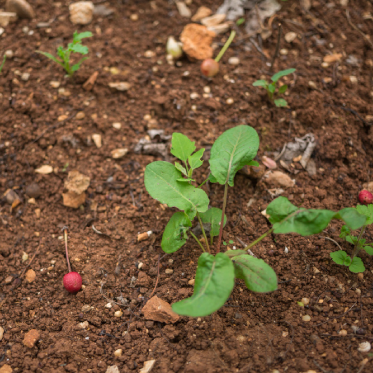Certainly! Quality defects in pomegranates can significantly impact their market value and consumer satisfaction. Understanding these defects and their solutions is crucial for farmers and producers to maintain high-quality standards. Here’s a detailed look at common quality defects in pomegranates and the methods to address them:
Common Quality Defects in Pomegranates
- Cracking and Splitting
- Description:The fruit splits open, exposing the arils and making it susceptible to rot and pests.
- Causes:
- Rapid changes in temperature and humidity.
- Excessive water uptake, especially during the final stages of fruit development.
- Nutrient imbalances, particularly calcium deficiency.
- Solutions:
- Maintain consistent irrigation practices to avoid sudden water stress.
- Apply calcium-rich fertilizers to ensure adequate nutrient levels.
- Use mulching to regulate soil moisture and temperature.
- Sunburn and Sunscald
- Description:The fruit develops brown or black spots on the sun-exposed side, leading to reduced quality and shelf life.
- Causes:
- Intense sunlight and high temperatures.
- Lack of proper canopy cover.
- Solutions:
- Provide adequate canopy cover to protect the fruit from direct sunlight.
- Use reflective mulches or whitewash on the fruit to reduce heat absorption.
- Ensure proper spacing between trees to allow for better air circulation and shading.
- Pest and Disease Infestations
- Description:Damage caused by insects, mites, and diseases can lead to blemishes, deformities, and reduced yield.
- Causes:
- Insects like the pomegranate butterfly, mealybugs, and aphids.
- Diseases such as black spot, anthracnose, and powdery mildew.
- Solutions:
- Implement integrated pest management (IPM) techniques, including biological control, mechanical control, and minimal chemical use.
- Use disease-resistant varieties.
- Regularly monitor the orchard for signs of pests and diseases and take prompt action.
- Maintain good orchard hygiene by removing infected plant material and debris.
- Fruit Drop
- Description:Premature falling of fruits from the tree, leading to reduced yield.
- Causes:
- Water stress, either from over-irrigation or under-irrigation.
- Nutrient deficiencies, particularly nitrogen and potassium.
- Pests and diseases.
- Solutions:
- Ensure consistent and appropriate irrigation.
- Apply balanced fertilizers to meet the nutrient needs of the trees.
- Control pests and diseases through regular monitoring and IPM practices.
- Internal Browning
- Description:Browning of the arils inside the fruit, which can affect taste and appearance.
- Causes:
- Mechanical damage during handling and transportation.
- Exposure to high temperatures.
- Nutrient deficiencies, particularly boron.
- Solutions:
- Handle fruits gently during harvesting and packing to avoid mechanical damage.
- Use boron-rich fertilizers to ensure adequate nutrient levels.
- Store fruits in a cool, well-ventilated area to prevent heat damage.
- Poor Color Development
- Description:Fruits that do not develop the characteristic deep red color, which can affect marketability.
- Causes:
- Insufficient sunlight.
- Nutrient deficiencies, particularly potassium and phosphorus.
- Genetic factors.
- Solutions:
- Ensure that trees receive adequate sunlight by proper pruning and spacing.
- Apply potassium and phosphorus fertilizers as needed.
- Choose varieties that are known for their good color development.
- Small Fruit Size
- Description:Fruits that are smaller than the desired size, which can reduce market value.
- Causes:
- Insufficient water and nutrient supply.
- Overcrowding of trees.
- Poor pollination.
- Solutions:
- Provide adequate water and balanced fertilizers.
- Maintain proper tree spacing and pruning to ensure good air circulation and sunlight exposure.
- Use pollination techniques, such as hand pollination or attracting pollinators, to improve fruit set.
- Mold and Rot
- Description:Fungal infections that cause the fruit to rot, often visible as white or gray mold on the surface.
- Causes:
- High humidity and poor air circulation.
- Infected soil or plant material.
- Inadequate post-harvest handling and storage.
- Solutions:
- Ensure good air circulation in the orchard by proper pruning and spacing.
- Remove and destroy infected plant material to prevent the spread of disease.
- Use fungicides as a preventive measure, but only as needed and in accordance with best practices.
- Store fruits in a cool, dry place with good ventilation.
- Bitterness
- Description:Unpleasant bitter taste in the fruit.
- Causes:
- Over-maturity.
- Genetic factors.
- Soil and water conditions.
- Solutions:
- Harvest fruits at the optimal maturity stage.
- Choose varieties that are known for their sweet taste.
- Maintain good soil and water management practices.
Best Practices for Quality Management
- Regular Monitoring:
- Conduct regular inspections of the orchard to identify and address issues early.
- Use tools like soil moisture sensors and weather stations to monitor environmental conditions.
- Proper Harvesting:
- Harvest fruits at the right maturity stage to ensure optimal taste and appearance.
- Use clean, sharp tools to avoid damage during harvesting.
- Post-Harvest Handling:
- Handle fruits gently to avoid bruising and mechanical damage.
- Sort and grade fruits immediately after harvesting to remove any defective ones.
- Use appropriate packaging materials to protect the fruits during transportation and storage.
- Storage Conditions:
- Store pomegranates in a cool, dry place with good ventilation to prevent mold and rot.
- Maintain a temperature of around 7-10°C (45-50°F) and a relative humidity of 85-90%.
- Soil and Water Management:
- Test soil regularly to ensure it has the right nutrient balance.
- Use efficient irrigation systems like drip irrigation to maintain consistent water supply.
- Implement water conservation techniques such as mulching and rainwater harvesting.
- Integrated Pest Management (IPM):
- Use a combination of biological, mechanical, and chemical methods to control pests and diseases.
- Introduce beneficial insects and natural predators to reduce pest populations.
- Apply chemical pesticides only as a last resort and in minimal quantities.
- Genetic Selection:
- Choose high-quality, disease-resistant varieties that are well-suited to the local climate and soil conditions.
- Consider hybrid varieties that offer improved yield and quality.
Quality Defects Identified:
- Cracking and Splitting: Some fruits were splitting open, especially after heavy rains.
- Sunburn and Sunscald: Fruits on the sun-exposed side were developing brown spots.
- Pest Infestations: Mealybugs were causing blemishes on the fruits.
Solutions Implemented:
- Cracking and Splitting:
- Installed a drip irrigation system to maintain consistent water supply.
- Applied calcium-rich fertilizers to strengthen the fruit’s skin.
- Used mulching to regulate soil moisture and temperature.
- Sunburn and Sunscald:
- Pruned trees to ensure better canopy cover and protect fruits from direct sunlight.
- Used reflective mulches to reduce heat absorption.
- Ensured proper spacing between trees to allow for better air circulation.
- Pest Infestations:
- Introduced beneficial insects like ladybugs to control mealybug populations.
- Set up pheromone traps to monitor and reduce pest infestations.
- Applied minimal chemical pesticides as needed and in accordance with best practices.
Outcome:
- Reduced Defects: The farm saw a significant reduction in fruit cracking, sunburn, and pest infestations.
- Improved Quality: The overall quality of the pomegranates improved, leading to better market prices and customer satisfaction.
- Sustainable Practices: The farm’s sustainable practices reduced environmental impact and improved long-term soil health.
By addressing these common quality defects and implementing best practices, farmers can ensure that their pomegranates are of the highest quality, enhancing their market value and consumer appeal.









